Backflow preventers are an essential device needed in a plumbing system to prevent the flow of water in a reverse direction. Some of the signs of backflow include discolored water, slow drainage, and water leaks. To mitigate the harmful effects of backflow, high-quality backflow preventers should be used, and backflow testing should be carried out regularly.
Continue reading this article to learn more about the different types of backflow preventers and the factors to consider before buying a backflow preventer.
What Is Backflow Preventer?
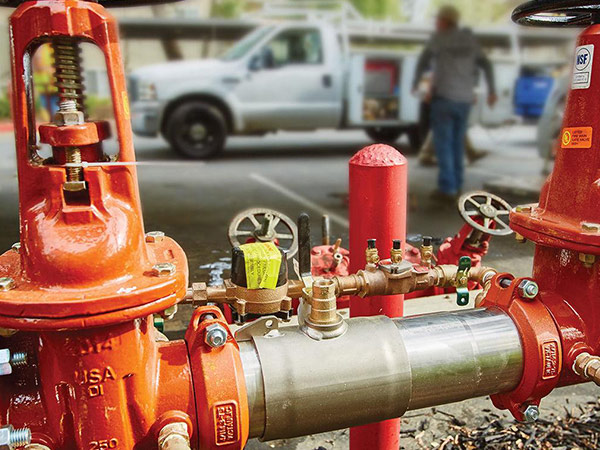
When water moves back in a reverse direction, contaminants travel from the unclean water source to the good (drinking) water source. To prevent the potable water source from contamination, it is essential to invest in backflow preventer devices.
Backflow prevention device types are installed within a plumbing system to ensure that water flow is in the proper direction. The main function of a backflow preventer valve is to prevent water from moving in an opposite direction.
Backflow occurs in a plumbing system due to back pressure and back-siphonage. One major way to confirm if a backflow preventer is working perfectly or if backflow is occurring in a plumbing system is by carrying out a backflow test.
How Do Backflow Preventers Work
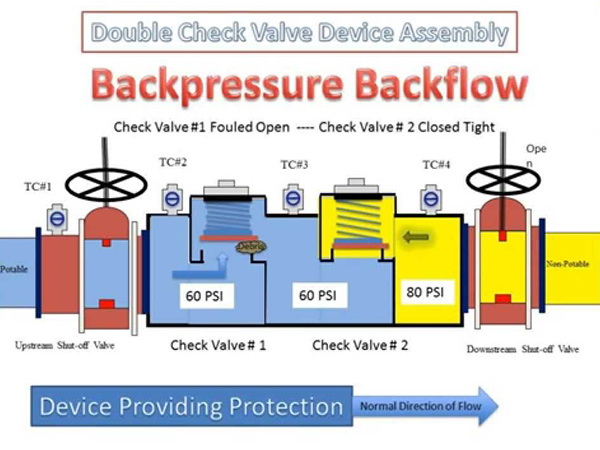
Backflow preventers are responsible for preventing water supply from moving in an opposite direction. Backflow preventers consist of a valve that prevents the main supply of water from the sanitary water in a plumbing system.
Under normal circumstances, backflow may not occur in a good plumbing system. However, there are cases like broken water lines that may reduce water pressure. During such cases, water may flow in a reverse direction back into the main water supply line. Thus, contaminants may flow back to the potable water source if a backflow preventer is not available.
Common places where backflow preventers are installed are in cross-connections or connections that consist of two different water systems (potable and non-potable water systems). For instance, they are used in sprinkler irrigation systems or other plumbing systems that contain hazardous chemicals to prevent backflow into the potable water system.
Backflow preventers must be tested and approved before they are installed in a plumbing system. This is why it is very important to buy from licensed and reliable industrial valve companies. Dombor is a leading industrial valve manufacturer in China that produce different types of backflow preventers.
Types of Backflow Preventers
It is essential for backflow preventers marketers and distributors to know the backflow prevention devicesto supply that will satisfy their customers’ needs. There are two types of backflow valves, and they are:
- Backflow prevention devices
- Backflow prevention assemblies
The backwater valve types listed above are available in industrial valve companies. To get high-quality valves, it is very important to buy from a certified industrial ball valvesmanufacturer.
Types of Backflow Devices
Backflow prevention device stops water from flowing in the opposite direction. Industrial valves regulate fluid flow in industrial processes. The two types of backflow devices are:
1. Industrial valve
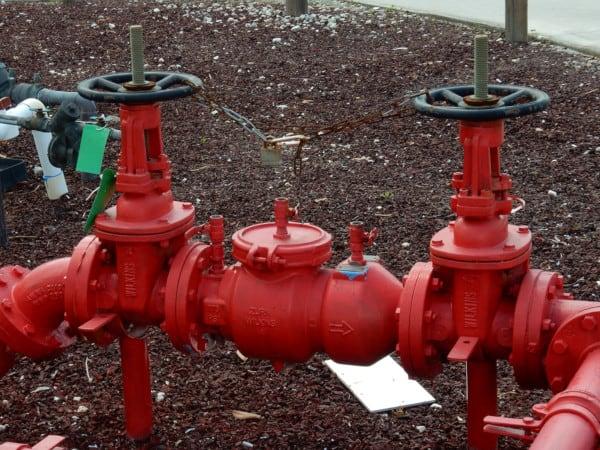
Industrial valves play a crucial role in backflow prevention systems by controlling the flow of fluids and gases in pipes and preventing contaminated water from flowing back into the potable water supply. These valves work by automatically closing when the pressure in the system drops below a certain level, which prevents the backflow of non-potable water or other fluids into the main water supply.
There are various types of industrial valves used in backflow prevention systems, including check valves, pressure relief valves, and vacuum breakers, each designed to address specific issues related to backflow prevention. Proper installation and maintenance of industrial valves are critical to ensuring the safe and efficient operation of backflow prevention systems, which are essential for protecting public health and the environment.
2. Atmospheric Vacuum Breakers (AVBs)
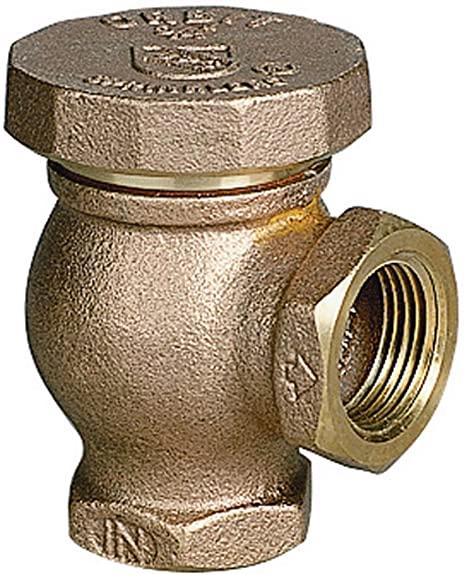
This is the least expensive and simplest backflow device, and it is commonly used for one and two-zone irrigation systems. This type of backflow should be installed vertically because it is a gravity-operated device. AVBs function properly with the help of air pressure instead of water pressure.
For effective operation, it must be installed on every sprinkler zone valve after each control valve. Therefore, they are not suitable for complex plumbing systems with more than six control valves because are not cost-effective.
Atmospheric vacuum breakers (AVBs) are the least reliable and it is not advisable to use them in areas that are under constant pressure. Also, they only offer protection against back siphonage – they cannot prevent back pressure.
3. Backflow Prevention Assemblies
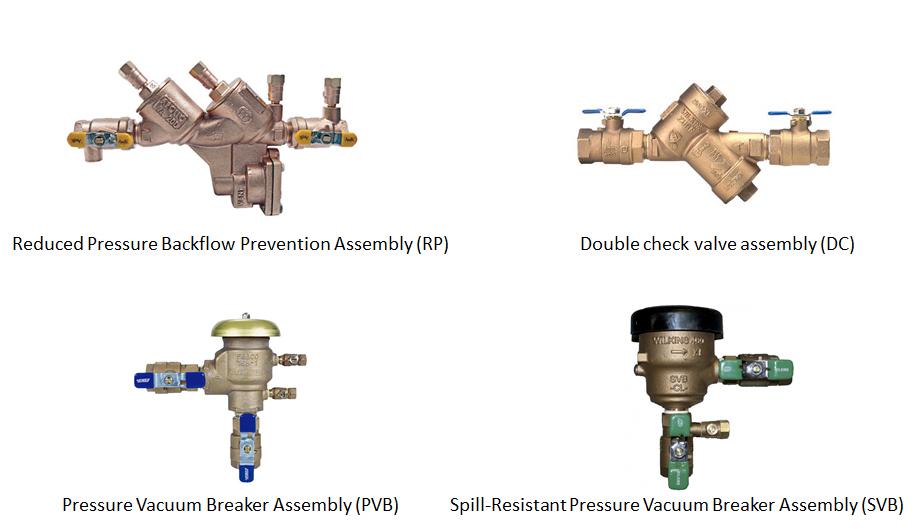
Backflow prevention assemblies is a backflow device that contains all the needed shutoffs and valves that are required for testing. So, they can be easily tested even after installation to confirm their effective function. Unlike AVBs, backflow prevention assemblies prevent both back siphonage and back pressure.
Below are some of the common types of backflow prevention assemblies:
- Double Check Valves
- Pressure Vacuum Breaker Assembly
- Spill-Resistant Vacuum Breaker Assembly
- Reduced Pressure Backflow Prevention Assembly
How To Choose the Right Backflow Prevention Device Types
Choosing the right backflow preventer out of the numerous types of backflow preventers might be a daunting task. Thus, here are some of the factors that suppliers need to consider when choosing backflow valve types for their customers:
1. The Complexity of Installation and Maintenance
Many people prefer to go for devices that are very easy to install. Also, maintenance and future repair should be kept in mind. For instance, many people prefer AVBs because it is easier to install and maintain.
2. Range of Coverage
Atmospheric vacuum breakers (AVBs) cannot be used in a complex plumbing system. However, it can be used in simple plumbing systems that do not have more than six plumbing systems. The level of protection needed in a system can be used to determine the right backflow prevention device.
3. Cost
Backflow preventers vary in price because they are available in different types, sizes, and shapes. The least expensive backflow preventer types are the AVBs, while the backflow prevention assemblies are the most complex and expensive option.
4. Application
The type of application your customers have in mind also determines the kind of backflow prevention device types you can supply them. For example, for most simple plumbing systems, Atmospheric vacuum breakers (AVBs) is suitable. However, for more complex applications, other devices will be more suitable.
Conclusion
To effectively treat water from contamination, it is essential to invest in high-quality and reliable types of backflow devices from a certified and reliable backflow and butterfly valves manufacturer.
Dombor is a leading industrial valve manufacturer in China that specializes in producing different types of valves for both residential and industrial applications. Dombor is a certified manufacturer and is widely known for consistently producing high-quality valves. Contact us today to learn more about our products.









